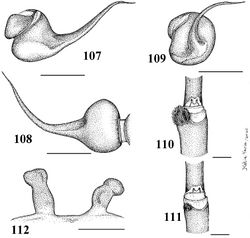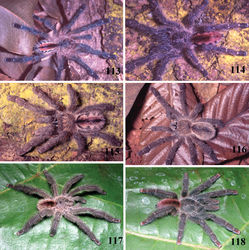Iridopelma zorodes
| Notice: | This page is derived from the original publication listed below, whose author(s) should always be credited. Further contributors may edit and improve the content of this page and, consequently, need to be credited as well (see page history). Any assessment of factual correctness requires a careful review of the original article as well as of subsequent contributions.
If you are uncertain whether your planned contribution is correct or not, we suggest that you use the associated discussion page instead of editing the page directly. This page should be cited as follows (rationale):
Citation formats to copy and paste
BibTeX: @article{Bertani2012ZooKeys230, RIS/ Endnote: TY - JOUR Wikipedia/ Citizendium: <ref name="Bertani2012ZooKeys230">{{Citation See also the citation download page at the journal. |
Ordo: Araneae
Familia: Theraphosidae
Genus: Iridopelma
Name
Iridopelma zorodes (Mello-Leitão, 1926) – Wikispecies link – Pensoft Profile
- Typhochlaena zorodes Mello-Leitão 1926[1]:322, f. 9–10.
- Avicularia zorodes: Petrunkevitch 1939[2]:289.
- Iridopelma zarodes: Smith 1993[3]:18; Peters 2003[4]:210, f. 847–848.
- Iridopelma zorodes: Platnick 2012[5].
Diagnosis
The males resemble those of Iridopelma vanini sp. n.and Iridopelma katiae sp. n. by leg I and IV having similar length (leg IV/I length = 0.93, SD = 0.01). It differs from Iridopelma vanini sp. n. by the shorter embolus (Figs 107–109). It differs from Iridopelma katiae sp. n. by general brown pattern and lack of a reddish pattern on abdomen dorsally (Fig. 117). Females differ from all other species by two straight to slightly curved spermathecae tapering little from base to apex, not folding and with a very slight constriction forming a single distal lobe (Fig. 112).
Types
Holotype male of Typhochlaena zorodes [dry, pinned] from Bahia, O. Torres, MNRJ 1408 [MLPC 900], not located (see Silva-Moreira et al. 2010[6]).
Additional material examined
BRAZIL: Sergipe: Areia Branca, Parque Nacional Serra de Itabaiana [10°44'S, 37°22'W], 1 male, A. C. M. Fernandes, 12 November 1996 (IBSP 11761); 1 female, R. Bertani, A. D. Brescovit, A. B. Bonaldo, September 1999 (IBSP 9421); 1 female, same data (IBSP 8545); 1 male, same data (IBSP 8543); 1 immature, same data (IBSP 8722); 1 immature, same data (IBSP 8954); 1 female, I. Matos, 1 November 1992 (IBSP 11760); Lagarto [10°54'S, 37°39'W], 1 female, Maxwell ded. September 1999 (IBSP 8026); Santa Luzia do Itanhy, Mata do Crasto [11°23'S, 37°24'W], 1 female, R. Bertani, A. D. Brescovit, A. B. Bonaldo, September 1999 (IBSP 8782); Santo Amaro das Brotas [10°46'S, 37°03'W], no collector data, 23 March 1978, inside bromeliad (MZSP 10847); São Cristóvão [11°00'S, 37°13'W], 1 female, A. D. Brescovit, 6 December 1996 (IBSP 9664); Bahia: Acajutiba [11°39'S, 38°01'W], 1 male, 1 female, E. Boaventura, 27 March 1991 (MZSP 32159, col. Bock. 696–697); 1 female, same data (MZSP 32160, col. Bock. 698); 5 females, 17 immatures, same collector, 18 April 1991 (MZSP 32181, col. Bock. 716, 800–820); 3 females, 2 immatures, same data (MZSP 32180, col. Bock. 795–799); Elísio Medrado, RPPN Jequitibá (12°52'3.20"S, 39°28'9.09"W) 1 female, R. H. Nagahama, R. Bertani, C. S. Fukushima, 7 October 2007, at night, inside bromeliad (MNRJ 06253); Salvador, Alphaville [12°56'S, 38°21'W], 1 male, G. G. Montingelli, 11–29 November 2001 (IBSP 9717); Ondina [13°00'S, 38°30'W] 1 immature, T. B. Nunes Ded. December 1982 (IBSP 7906); 1 male (REF 42901C); Mata de São João, RPPN Camarujipe [12°31 S, 38°02'W], 1 male, C. S. Fukushima, R. Bertani and R. H. Nagahama, 4 October 2007, at night on a leaf (MNRJ 06254); Paraná: Curitiba [25°25'S, 49°16'W], 1 immature, F. Cominese (MZSP 32161, Bock. 695) (prabably mislabeled).
Description
Female (IBSP 11760) from Areia Branca, Sergipe, Brazil. Carapace 12.8 long, 12.0 wide, chelicerae 6.3. Legs (femur, patella, tibia, metatarsus, tarsus, total): I: 10.8, 6.4, 8.1, 8.4, 4.1, 37.8. II: 9.8, 5.6, 6.9, 6.8, 3.6, 32.7. III: 8.4, 4.6, 6.0, 6.7, 3.4, 29.1. IV: 10.2, 5.3, 8.3, 8.8, 3.7, 36.3. Palp: 7.6, 4.4, 5.0, –, 5.3, 22.3. Mid-widths (lateral): femora I–IV = 2.3, 2.3, 2.4, 2.1, palp = 1.8; patellae I–IV = 2.4, 2.4, 2.4, 2.4, palp = 2.1; tibiae I–IV = 2.2, 2.1, 1.9, 2.1, palp = 1.9; metatarsi I–IV = 1.6, 1.5, 1.5, 1.4; tarsi I–IV = 1.8, 1.8, 1.8, 1.7, palp = 1.8. Abdomen 12.8 long, 9.5 wide. Spinnerets: PMS, 1.3 long, 0.7 wide, 0.3 apart; PLS, 1.6 basal, 1.0 middle, 1.9 distal; mid-widths (lateral), 1.1, 0.9, 0.7, respectively. Carapace: length to width 1.07. Fovea: deep, 2.1 wide. Eyes: tubercle 0.9 high, 1.6 long, 2.6 wide. Clypeus 0.4. Anterior eye row procurved, posterior straight. Eye sizes and inter-distances: AME 0.5, ALE 0.6, PME 0.4, PLE 0.5, AME–AME 0.4, AME–ALE 0.3, AME–PME 0.2, ALE–ALE 1.6, ALE–PME 0.5, PME–PME 1.4, PME–PLE 0.1, PLE–PLE 2.1, ALE–PLE 0.2, AME–PLE 0.4. Ratio of eye group width to length 2.2. Maxillae: length to width: 1.8. Cuspules: 90–100 spread over ventral inner heel. Labium: 1.2 long, 2.1 wide, with 80–100 cuspules spaced by one diameter from each other on the anterior third. Labio-sternal groove deep, narrow, with two sigilla. Chelicerae: basal segments with nine teeth decreasing in size from distal to basal portion. Sternum: 5.9 long, 4.8 wide. Legs: leg formula: I=IV II III. Scopula: tarsi I–IV fully scopulate, IV with some sparse setae. Metatarsi I–II 4/5 scopulate; III 2/3, IV 1/3 distal scopulate. IV divided by three wide row of setae. Urticating hairs type II (0.40 to 0.45 long, 0.01 wide) on the abdomen dorsum. Genitalia: paired straight to slightly curved spermathecae tapering slightly from base to apex, not folding, with very slight constriction forming single distal lobe (Fig. 112). Color pattern: carapace, chelicerae, legs and palps brown with light brown hairs; metatarsi, tibiae and patellae ventrally dark. All tarsi dorsally with a “U” shaped orange stripe. Sternum, labium and maxillae black. Coxae I black, except by brown retrolateral apical third; Coxae II–IV basal half black, distal half brown. Longitudinal stripes on dorsum of femora, patellae, tibiae and metatarsi light. Distal femora, patellae, tibiae and metatarsi with white rings. Abdomen venter black; lateral light brown; dorsal central area dark with reddish urticating hairs (Fig. 116).
Redescription
Male (MNRJ 06254) from Mata de São João, Camurujipe, state of Bahia, Brazil. Carapace 8.0 long, 7.6 wide, chelicerae 4.5. Legs (femur, patella, tibia, metatarsus, tarsus, total): I: 10.2, 4.7, 8.1, 8.3, 4.0, 35.3. II: 9.3, 4.1, 7.3, 7.5, 3.5, 31.7. III: 7.6, 3.6, 5.8, 6.4, 3.2, 26.6. IV: 9.5, 3.7, 7.9, 8.7, 3.4, 33.2. Palp: 5.6, 3.0, 4.1, –, 2.1, 14.8. Mid-widths (lateral): femora I –IV = 1.4, 1.5, 1.5, 1.4, palp = 1.2; patellae I–IV = 1.6, 1.5, 1.5, 1.8, palp = 1.3; tibiae I–IV = 1.4, 1.2, 1.1, 1.3, palp = 1.3; metatarsi I–IV = 0.9, 0.9, 0.9, 0.8; tarsi I–IV = 1.1, 1.1, 1.0, 1.0, palp = 1.2. Abdomen 8.7 long, 4.7 wide. Spinnerets: PMS, 0.9 long, 0.4 wide, 0.1 apart; PLS, 1.2 basal, 0.8 middle, 1.1 distal; mid-widths (lateral), 0.6, 0.6, 0.5, respectively. Carapace: length to width 1.05. Fovea: shallow, 1.3 wide. Eyes: tubercle 0.5 high, 1.4 long, 1.7 wide. Clypeus 0.2. Anterior eye row procurved, posterior straight. Eyes sizes and inter-distances: AME 0.5, ALE 0.3, PME 0.2, PLE 0.3, AME–AME 0.3, AME–ALE 0.1, AME–PME 0.1, ALE–ALE 1.1, ALE–PME 0.3, PME–PME 1.1, PME–PLE 0.08, PLE–PLE 1.2, ALE–PLE 0.2, AME–PLE 0.2. Ratio of eye group width to length 2.1. Other characters as in female, except: maxillae: length to width: 1.8. Cuspules: 90–100 spread over ventral inner heel. Labium: 0.8 long, 1.5 wide, with 70–80 cuspules spaced by one diameter from each other on the anterior third center. Labio-sternal groove shallow, flat, with two sigilla. Chelicerae: basal segments with eleven teeth decreasing in size from distal to basal portion. Sternum: 3.9 long, 3.3 wide. Legs: leg formula: I=IV II III. Scopula: Tarsi I–IV fully scopulate, IV with some sparse setae. Metatarsi I–II 2/3 scopulate; III 2/3 distal scopulate; IV 1/3 distal scopulate. IV divided by four wide row of setae. Tibial spur. Legs: I, single, 0.8 long, 1.0 wide (Fig. 110); II, 0.2 long, 0.7 wide (Fig. 111); both with numerous spiniform setae on tips. Urticating hairs type II (0.75 to 0.85 long, 0.015 to 0.02 wide) on the abdomen dorsum. Palp: embolus 2.2 long, with a 115° curvature to the retrolateral side. Embolus basal, middle and distal width of 0.4, 0.2 and 0.03, respectively. Tegulum 0.8 long, 1.2 wide. (Figs 107–109). Cymbium: spiniform process 0.4 long, 0.4 wide on the apex.
Distribution
Brazil: states of Sergipe and Northern Bahia (Fig. 169).
Spermathecae variation
Typical spermatheca is straight, or diverges little from its base; has no fold and apical portion is dilated (Figs 112, 123). Some spermathecae are shorter and taper considerably (Fig. 124), whereas others are long and curved distally (Fig. 126). The spermatheca of a specimen from Elísio Medrado, state of Bahia, is partially divided distally (Fig. 125). It is from the southermost distribution of the species and shows a different color pattern as well (Fig. 118).
Natural History
Individuals of Iridopelma zorodes inhabits remnants of Brazilian Atlantic rainforest. My own field observations in state of Sergipe (Areia Branca, Parque Nacional Serra de Itabaiana) and Santa Luzia do Itanhy (Mata do Crasto), indicate that individuals make retreats similar to those of Iridopelma hirsutum, i. e., leaves connected with silk threads. Eventually, they were found inside bromeliads. An adult male was found on a leaf in Camurujipe, São João da Mata, state of Bahia, in October.
Color pattern ontogeny
As Iridopelma hirsutum, but adult males and females lack or have an inconspicuous abdominal pattern (Figs 113–118).
Remarks
Even though the holotype is lost (Silva-Moreira et al. 2010[6]), Mello-Leitão’s (1926)[1] description provides some information that allows conspecific recognition, mainly leg I and IV of similar length, absence of a pattern on abdomen dorsum and type locality state of Bahia. Therefore, I consider this species valid.
Taxon Treatment
- Bertani, R; 2012: Revision, cladistic analysis and biogeography of Typhochlaena C. L. Koch, 1850, Pachistopelma Pocock, 1901 and Iridopelma Pocock, 1901 (Araneae, Theraphosidae, Aviculariinae) ZooKeys, 230: 1-94. doi
Other References
- ↑ 1.0 1.1 Mello-Leitão C (1926) Algumas Theraphosoideas novas do Brasil. Revista do Museu Paulista 14: 307-324.
- ↑ Petrunkevitch A (1939) Catalogue of American spiders. Part one. Transactions of the Connecticut Academy of Arts and Science 33: 133-338.
- ↑ Smith A (1993) Taxonomy focus. Journal of the British Tarantula Society 9: 13-18.
- ↑ Peters H (2003) Tarantulas of the World: Amerika’s Vogelspinnen. Published by the author, Wegberg, Germany, 328 pp.
- ↑ Platnick N (2012) The world spider catalog version 12.5. American Museum of Natural History. Available from: http://research.amnh.org/iz/spiders/catalog , doi: 10.5531/db.iz.0001 [accessed June 2012].
- ↑ 6.0 6.1 Silva-Moreira T, Baptista R, Kury A, Giupponi A, Buckup E, Brescovit A (2010) Annotated check list of Arachnida type specimens deposited in the Museu Nacional, Rio de Janeiro. II-Araneae. Zootaxa 2588: 1–91. http://www.mapress.com/zootaxa/2010/f/z02588p091f.pdf doi: 10.1074/jbc.M001491200
Images
|



